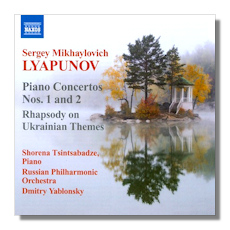
The Internet's Premier Classical Music Source
Related Links
- Lyapunov Reviews
- Latest Reviews
- More Reviews
-
By Composer
-
Collections
DVD & Blu-ray
Books
Concert Reviews
Articles/Interviews
Software
Audio
Search Amazon
Recommended Links
Site News
 CD Review
CD Review
Sergey Lyapunov

Concertos for Piano
- Piano Concerto #1 in E Flat minor, Op. 4
- Piano Concerto #2 in E Major, Op. 38
- Rhapsody on Ukrainian Themes, Op. 28
Shorena Tsintsabadze, piano
Russian Philharmonic Orchestra/Dmitry Yablonsky
Naxos 8.570783
Early in his career Sergey Mikhaylovich Lyapunov (1859-1924) came under the influence of the Russian Nationals, a group led by Mily Balakirev and whose members included Borodin, Rimsky-Korsakov, Mussorgsky and Cui. The works offered on this Naxos CD show the influence of some of these, to be sure, but more than anything else, it is the voice of Liszt that is most noticeable here, particularly in the piano writing. It is understandable that Lisztian elements would creep into the First Concerto, a work written in 1890, when the composer was turning thirty and still developing his style. But the Second Concerto, completed in 1909, is even more beholden to Liszt.
That said, the music is not pure imitation – Lyapunov's own Russian soul, his thematic prowess and sense for dazzling pyrotechnics also infuse this music with a character of its own. The First Concerto, like the Second, is cast in one movement and lasts about twenty-two minutes. At the outset it calls to mind the opening of the Borodin Symphony #2, but once the piano enters, hints of Liszt appear. The keyboard writing is always skillful and very colorful though, and thematic material is clearly Russian, not a product of Liszt's New German School.
The Second Concerto is probably the stronger work here, even though it doesn't suggest much stylistic evolution by the composer. It's shorter than the First by about three minutes and features some very attractive themes and the usual brilliant piano writing. It also has quite a dazzling ending that calls to mind the Liszt Second, replete with glissandos and a dash of bombast.
The Rhapsody on Ukrainian Themes is a bit shorter still and cast in a rondo form. It too is in one movement, and, not surprisingly, features a more exotic character to its thematic material, all folk-derived as the title suggests. Like its companion pieces here, it is also very Lisztian: beginning at 5:45 the piano writing is heavily suggestive of Liszt, and at about 6:00 you think the music is going to slide right into the last section of Liszt's Sixth Rhapsody. Even some of the brassy parts of the orchestration that follow carry more than a hint of Liszt. I don't want to engage in overkill about the Lisztian connections here, since this work is actually quite good.
In the end, all three pieces should appeal to those listeners interested in Romantic and post-Romantic piano music. These works are unabashedly Romantic to the core and contain many appealing themes, with highly-skilled piano writing. Moscow-born pianist Shorena Tsintsabadze, a student of Oxana Yablonskaya (mother of the conductor here), catches the fire and the poetry of the music, meets its pyrotechnical demands with relative ease and imparts a wonderful sense of imagination to her interpretations. Dmitry Yablonsky draws fine performances from the Russian Philharmonic Orchestra, and Naxos provides excellent sound. Recommended.
Copyright © 2011, Robert Cummings





















